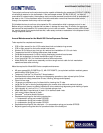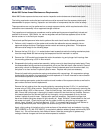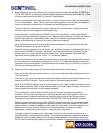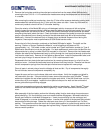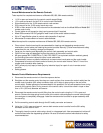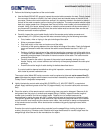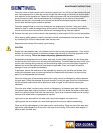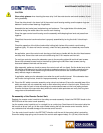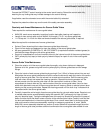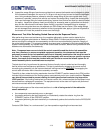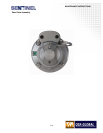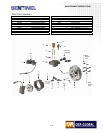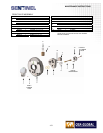
MAINTENANCE INSTRUCTIONS
4.14
CAUTION
Wear safety glasses when inserting the wear strip. It will be under tension and could suddenly fly out
during assembly.
Place the drive wheel in the lower half of the control crank housing making sure the spacer rings are
between it and the wheel bearings if applicable.
Assemble the two brake jaws, brake bearing and brake arm. The angled sides of the brake jaws
should be facing the retract side of the control crank housing.
Place the upper control crank housing over the assembly while keeping them level and press them
together.
Check that the control crank mechanism is properly assembled by turning the shaft. It should spin
freely.
Check the operation of the friction brake while holding both halves of the control crank housing
together tightly. If it does not function correctly, check for faulty assembly or excessively worn brake
jaws.
As applicable, mount the control crank housing on the frame or handle with the four bind head screws
and stop nuts. Secure the crank arm to the shaft using the 5/16 in washer and hex bolt.
For reel type controls, secure the odometer cover to the mounting plate with two bind head screws.
Secure the odometer's reset knob to the shaft by tightening the two Allen head screws, leaving
clearance between the knob and the cover.
After assembly, perform a check to ensure the control crank will turn freely. Set the brake lever to the
ON position and attempt to turn the handle using moderate pressure. Do not apply excessive force.
Run a section of the control cable through the control crank to ensure the control crank operates
easily without snags or resistance.
If applicable, make sure the odometer turns when the crank handle is turned. If the odometer does
not function during this test, check for improper assembly or damaged parts.
11 Clean the 661 safety connector assembly using a brush and solvent. Ensure the movable jaws of the
safety connector are not excessively loose or worn where they swivel in the clevis pins. Examine the
connector collar for bent or loose connecting pins and excessive wear on the inner-mating surface.
Examine the face of the connector body where the control cable protrudes and verify that long-term
usage has not chamfered the area.
Re-assembly of the Remote Control Unit:
Reattach the remote control conduits to the safety connector assembly. Attach the EXPOSE sheath to the
EXPOSE side of the control crank assembly.
Lay the remote control conduits out in a straight line or a wide loop. Feed the end of the control cable into
the conduit as far as it will go. As the control cable is being fed into the remote control conduits, feel for
any resistance that indicates damage of the remote control conduit.
Turn the control crank handle in the RETRACT direction until the end of the control cable is protruding.
Screw the safety stop spring onto the end of the control cable approximately 2 in (50 mm) from the end.



